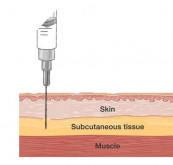Ustekinumab is used to treat inflammatory bowel diseases such as moderate to severe Crohn's disease and ulcerative colitis. Ustekinumab is usually used when other treatments haven't worked well.
Note: Ustekinumab has also been used for plaque psoriasis and psoriatic arthritis but it isn't funded for these uses.
Ustekinumab belongs to a group of medicines known as monoclonal antibodies. For Crohn’s disease and ulcerative colitis, ustekinumab works by blocking some natural inflammatory substances in your body. This helps to decrease swelling (inflammation) in the gut, which eases symptoms and may slow or stop damage from these bowel disorders.
Love our website? We do too. Did you know we're a charity? Donate now to help us keep it free for everyone in Aotearoa New Zealand.
Ustekinumab
Sounds like 'US-te-KIN-ue-mab'
Key points about ustekinumab
- Ustekinumab is used to treat some types of autoimmune conditions, such Crohn's disease and ulcerative colitis.
- Ustekinumab is also called Stelara.
- Find out about it and possible side effects.

For the treatment of Crohn’s disease or ulcerative colitis ustekinumab is given in 2 stages.
First dose: The first dose of ustekinumab is given by slow injection into a vein in your arm (called intravenous infusion), by a doctor or nurse. The first dose of ustekinumab is different for different people, depending on your body weight.
All subsequent doses: After this starting dose, all future doses of ustekinumab are given by injection just under the skin (subcutaneously), usually 90mg every 8 weeks. Ustekinumab comes as a ready-to-use, prefilled syringe that contains one dose (90mg).

Some people who are able to, and who have received training from a healthcare professional, can give themselves the subcutaneous injection. Otherwise it can be given by another person (eg, a family/whānau member or friend after proper training, or by your doctor or nurse). If you're unsure about how to inject ustekinumab or if you have any questions, always ask your doctor, nurse or pharmacist to show you.
Preparation
Store ustekinumab syringes in the fridge. It's best to bring the syringe up to room temperature before using it. You can take it out of the fridge 15 to 30 minutes before you use it, or warm it in your hands for about 1 minute. Don't warm it in the microwave or in hot water. Syringes may be stored out of the fridge for a maximum of 30 days. Write the date on the pack if you take them out of the fridge and use them within 30 days.
Injection site
Choose an injection site on the front of your thighs or your abdomen (belly) at least 5 cm from your belly button. The injection site should be different from your last injection site to prevent any bruising or thickening of the skin. Don't inject into a red or swollen area. Don't put the needle in too deep, it only needs to go under the skin.
Missed doses
If you miss a dose, inject it as soon as you remember. If you're within a day of your next injection, forget the missed one and carry on with your usual schedule. Don't take extra injections to make up for a forgotten dose.
Here are some things to know when you're taking ustekinumab. Other things may be important as well, so ask your healthcare provider what you should know about.
- Let your doctor or pharmacist know if you are allergic to latex.
- Ustekinumab weakens your body’s defence (immune) system, so you're more likely to pick up infections. It's important to avoid anyone who has chickenpox or shingles.
- Tell your doctor if you become pregnant while using ustekinumab.
- Some vaccines shouldn't be taken if you are on ustekinumab. Always check with your doctor or pharmacist first. It's safe for you to have the annual flu vaccine.
- Ustekinumab may interact with a few medicines and herbal supplements, so check with your doctor or pharmacist before starting ustekinumab or before starting any new medicines, including those you may buy over-the-counter.
Like all medicines, ustekinumab can cause side effects, although not everyone gets them. Often side effects improve as your body adjusts to the new medicine.
| Side effects | What should I do? |
|---|---|
|
|
|
|
|
|
|
|
|
|
| Read more about medicines and side effects and reporting a reaction you think might be a side effect. | |
References
- Ustekinumab(external link) NZ Formulary, NZ
- Stelara(external link) data sheet Medsafe, NZ
Brochures

Medicines and side effects
Healthify He Puna Waiora, NZ, 2024

Health Quality and Safety Commission, NZ, 2019 English, te reo Māori
Credits: Sandra Ponen, Pharmacist, Healthify He Puna Waiora. Healthify is brought to you by Health Navigator Charitable Trust.
Reviewed by: Angela Lambie, Pharmacist, Auckland
Last reviewed:
Page last updated:





